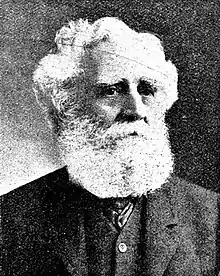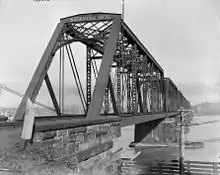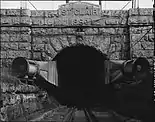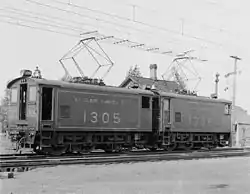Joseph Hobson
Joseph Hobson (1834–1917) was a Canadian land surveyor and railway design engineer. Early in his career he apprenticed under various professionals and became a provincial land surveyor when he was 21 years old. He did layout work for towns and counties in Ontario.
Joseph Hobson | |
|---|---|
 1909 | |
| Born | 1834 |
| Died | 1917 (aged 82–83) |
| Nationality | Canadian |
| Occupation | Land surveyor, civil engineer |
Hobson became an assistant engineer for the Grand Trunk Railway railroad company and did railway surveys. Advancing in his career he became the chief engineer for the Great Western Railway. Hobson was the resident engineer during the construction of the International Railway Bridge between the United States and Canada in the 1870s. He designed the first St. Clair railway tunnel. This was the first underwater railway tunnel between Canada and the United States. When it opened in 1891 it was the first undersea tunnel linking two distinct countries and the longest undersea tunnel then constructed.
Hobson, who was married in 1856, had six children. He retired in 1907, and worked as a consultant until his death in 1917.
Early life and education
Hobson was born in 1834 in Guelph Township in Wellington County, Ontario.[1] He had a brother, John, who was born in 1835. Hobson's parents were Joseph and Margaret Hobson. He attended log schoolhouses in Guelph for his primary schooling. In 1855 he went to Berlin, Canada.[2]
Career
Surveying
He apprenticed with John Tully as a land surveyor. During this time he did layout plans for the Ontario towns of Kitchener and Guelph. Later he apprenticed under M. C. Schofield[3] and passed his final exam as provincial land surveyor.[2]
Civil engineering
In 1856, Hobson joined the firm of Gzowski and McPherson in Toronto.[4] He returned to Kitchener in 1858 from Toronto to work for the county of Waterloo as their engineer on a part-time basis. Besides being the county engineer he also did private surveying. One of his contracts was the surveying of the township of Bidwell on Manitoulin Island. Hobson was later an assistant engineer on the construction of the Grand Trunk Railway from St. Marys to Sarnia. He was also engaged in railway surveys in Nova Scotia and also in the United States. Hobson lived in Guelph from the mid 1860s to the mid 1870s. From the summer of 1869 to the spring of 1870 he was an engineer to George Lowe Reid, chief engineer of the Great Western Railway. He assisted in the building of the Wellington, Grey and Bruce Railway from Guelph to Southampton.[1]

between Canada and New York state
Hobson in 1870 became chief engineer of the Great Western Railway. When it merged with the Grand Trunk Railway he was then the chief engineer of the Grand Trunk West of Toronto.[5] He was the onsite engineer for the construction of the International Railway Bridge from 1870 to 1873.[6] It crossed the Niagara River between Fort Erie, Ontario and Buffalo, New York. The half-mile long (0.80 km) bridge was contracted for $1 million when construction started in 1870. On its completion at the end of 1873 Hobson was promoted to assistant engineer of the Great Western Railway.[7] He was further promoted to chief engineer in 1875.[8] He moved to Hamilton, Canada soon thereafter but traveled often to Buffalo.[9] Hobson became chief engineer in 1882 of the Grand Trunk Railway west of Toronto.[1][10][11]
Hobson was appointed chief engineer to design and build the St. Clair Tunnel in 1886 between Sarnia in Ontario and Port Huron, Michigan.[12][13] The tunnel was constructed within a year at a cost of $2,700,000.[14][15] The first trains ran through on September 20, 1891.[16] It was then the first undersea tunnel linking two distinct countries, and the longest then constructed, at 6,025 feet (1,836 m) portal to portal.[17] Total length of the tunnel counting the approaches was 11,500 feet (3,500 m). After this project Hobson became chief engineer for the entire Grand Trunk Railway in 1896.[18][19][20] The tunnel was converted to run electric trains in 1908.[17]
Hobson was a member of the Canadian and American Societies of Civil Engineers and a member of the Institution of Civil Engineers of London, England.[21] He was a railway administrator that approved bidding contracts submitted to railroad companies for sub-contracting.[22]
 St Clair 1890 tunnel entrance
St Clair 1890 tunnel entrance Electric engine locomotive,
Electric engine locomotive,
1500 horse power Line of excavation
Line of excavation
engineering drawing St Clair tunnel
St Clair tunnel
engineering drawing
Personal life
Hobson married Elizabeth Laidlaw of Guelph in 1856.[2] They had two sons and four daughters. He retired from the railway industry in 1907, but continued as a railway consultant until his death in 1917 at the age of 84.[2]
References
- Chilton 1918, p. 236.
- "Waterloo Region Generations /Joseph Hobson". Retrieved October 2, 2020.
- "Personal and Pertinent". The Ottawa Journal. Ottawa, Canada. July 8, 1897. p. 4 – via Newspapers.com
 .
. - Ball 1988, p. 24.
- "The Tunnel at Port Huron". The Evening Republican. Meadville, Pennsylvania. December 17, 1890. p. 7 – via Newspapers.com
 .
. - "The St. Clair Tunnel". The Inter Ocean. Chicago, Illinois. February 22, 1891. p. 25 – via Newspapers.com
 .
. - "A Great Engineer". The Englewood Chief. Englewood, Kansas. May 18, 1892. p. 4 – via Newspapers.com
 .
. - Joseph Hobson, chief engineer of the St Clair tunnel – Opening of the St Clair River Tunnel, XXXV, no.1815, Harper's Weekly, October 3, 1891, pp. 758–760
- "The Railroads / Notes". Buffalo Morning Express. Buffalo, New York. July 30, 1881. p. 4 – via Newspapers.com
 .
. - "A Trip of Inspection". The Gazette. Montreal, Canada. July 20, 1886. p. 1 – via Newspapers.com
 .
. - "Civil Engineers". The Gazette. Montreal, Canada. January 10, 1899. p. 8 – via Newspapers.com
 .
. - "A Great Tunnel Project". St. Albans Daily Messenger. Saint Albans, Vermont. October 18, 1886. p. 2 – via Newspapers.com
 .
. - "The St. Clair Tunnel". The Weekly Republican. Newton, Kansas. March 20, 1891. p. 4 – via Newspapers.com
 .
. - "Joseph Hobson made dream of river tunnel come true". The Times Herald. Port Huron, Michigan. June 22, 1949. p. 92 – via Newspapers.com
 .
. - "Connected with Canada by a Tunnel". The Baltimore Sun. Baltimore, Maryland. September 25, 1891. p. 2 – via Newspapers.com
 .
. - "A hole into Canada". The Topeka State Journal. Topeka, Kansas. September 20, 1891. p. 1 – via Newspapers.com
 .
. - Kane 1997, p. 232.
- Middleton 2007, p. 526.
- "Dominion of Canada". Ottawa Daily Citizen. Ottawa, Canada. January 31, 1896. p. 2 – via Newspapers.com
 .
. - "Despatches in brief". The Ottawa Journal. Ottawa, Canada. January 31, 1896. p. 3 – via Newspapers.com
 .
. - "Josheph Hobson". Scientific American. 1891. p. 197. Retrieved October 2, 2020.
- "Grand Trunk Railway". The Gazette. Montreal, Canada. July 9, 1892. p. 28 – via Newspapers.com
 .
.
Sources
- Ball, Norman R. (1988). Mind, Heart, and Vision. National Museum of Science & Technology. ISBN 978-0-660-12000-3.
- Chilton (1918). Iron Age. Chilton Company.
- Kane, Joseph Nathan (1997). Famous First Facts, Fifth Edition. The H. W. Wilson Company. ISBN 0-8242-0930-3.
The first underwater railroad tunnel to a foreign country was the St. Clair Railway tunnel between Port Huron, MI, and Sarnia, Ontario, Canada, which was opened for freight traffic on September 19, 1891, and for passenger traffic on December 7. The tunnel was designed and built under the supervision of Joseph Hobson, chief engineer of the Grand Trunk Railway (later the Canadian National Railways), at a cost of $2.7 million. Its length from portal to portal was 6,025 feet. The tunnel was equipped with electricity on May 17, 1908.
- Middleton, William D. (2007). Encyclopedia North American Railroads. Indiana University Press. ISBN 978-0-253-34916-3.